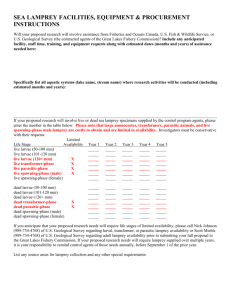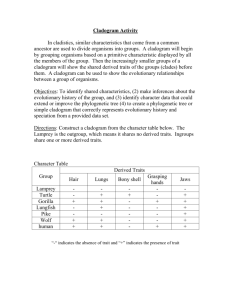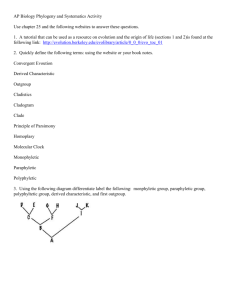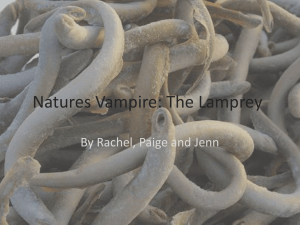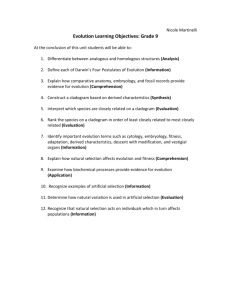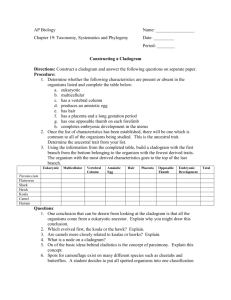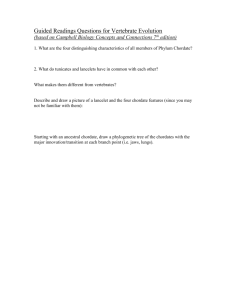Cladogram - Science A 2 Z
advertisement
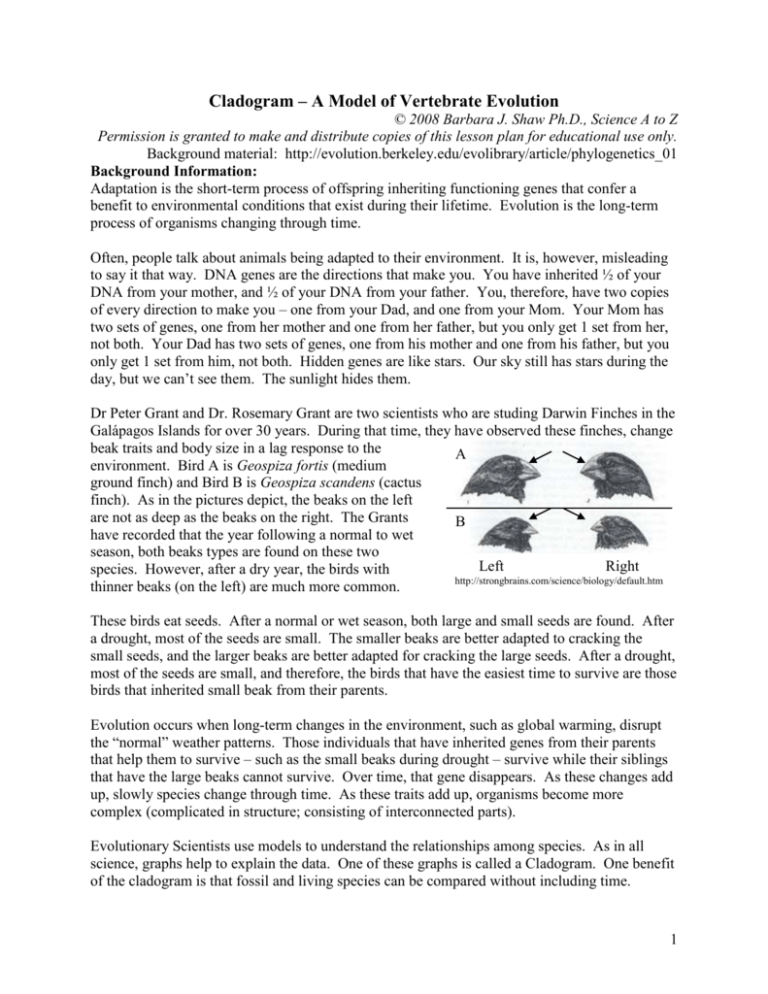
Cladogram – A Model of Vertebrate Evolution © 2008 Barbara J. Shaw Ph.D., Science A to Z Permission is granted to make and distribute copies of this lesson plan for educational use only. Background material: http://evolution.berkeley.edu/evolibrary/article/phylogenetics_01 Background Information: Adaptation is the short-term process of offspring inheriting functioning genes that confer a benefit to environmental conditions that exist during their lifetime. Evolution is the long-term process of organisms changing through time. Often, people talk about animals being adapted to their environment. It is, however, misleading to say it that way. DNA genes are the directions that make you. You have inherited ½ of your DNA from your mother, and ½ of your DNA from your father. You, therefore, have two copies of every direction to make you – one from your Dad, and one from your Mom. Your Mom has two sets of genes, one from her mother and one from her father, but you only get 1 set from her, not both. Your Dad has two sets of genes, one from his mother and one from his father, but you only get 1 set from him, not both. Hidden genes are like stars. Our sky still has stars during the day, but we can’t see them. The sunlight hides them. Dr Peter Grant and Dr. Rosemary Grant are two scientists who are studing Darwin Finches in the Galápagos Islands for over 30 years. During that time, they have observed these finches, change beak traits and body size in a lag response to the A environment. Bird A is Geospiza fortis (medium ground finch) and Bird B is Geospiza scandens (cactus finch). As in the pictures depict, the beaks on the left are not as deep as the beaks on the right. The Grants B have recorded that the year following a normal to wet season, both beaks types are found on these two Left Right species. However, after a dry year, the birds with http://strongbrains.com/science/biology/default.htm thinner beaks (on the left) are much more common. These birds eat seeds. After a normal or wet season, both large and small seeds are found. After a drought, most of the seeds are small. The smaller beaks are better adapted to cracking the small seeds, and the larger beaks are better adapted for cracking the large seeds. After a drought, most of the seeds are small, and therefore, the birds that have the easiest time to survive are those birds that inherited small beak from their parents. Evolution occurs when long-term changes in the environment, such as global warming, disrupt the “normal” weather patterns. Those individuals that have inherited genes from their parents that help them to survive – such as the small beaks during drought – survive while their siblings that have the large beaks cannot survive. Over time, that gene disappears. As these changes add up, slowly species change through time. As these traits add up, organisms become more complex (complicated in structure; consisting of interconnected parts). Evolutionary Scientists use models to understand the relationships among species. As in all science, graphs help to explain the data. One of these graphs is called a Cladogram. One benefit of the cladogram is that fossil and living species can be compared without including time. 1 Finally, scientists like group similar objects and organisms. Astronomers classify (group) galaxies and stars. Chemists classify chemicals on how they react. Geologists classify rocks and minerals on their chemical composition. Biologists and Paleontologists organize life through a hierarchy (a classification of organisms into groups based on similarities of structure or origin, etc.). All life is subdivided into Domains of cell types of Bacteria, Archaea, and Eukarya (that is our cell type). Domain Eukarya are divided into the Kingdoms of Protists (single cell organisms like what you find in a drop of pond water), Plants, Fungus (mold, mildew, and mushrooms), and Animals. Kingdom Animalia is divided into 36 phyla (mostly worm-like organisms). Phylum Chordata is divided into 3 subphyla. Subphylum Vertebrata is divided into 7 Classes. As we work down the hierarchy, we group animals that are more and more similar. For example, mice and rats are more similar than cats. Domain Eukarya Kingdom Animalia Phylum Chordata Subphylum Vertebrata (vertebrae or the beginning of vertebrae in the jawless fish) Class Agnatha (jawless fish – lamprey and hagfish) Class Chondrichthyes (cartilage fish – sharks rays and skates) Class Osteichthyes (bony fish, like perch and coelacanth) Class Amphibians (amphibians – frogs and salamanders) 2 Class Reptilia (reptiles – turtles, snakes, lizards, crocodiles, and dinosaurs) Class Mammalia (mammals – platypus, kangaroos and rats) Class Aves (birds – ostriches and pigeons) http://bp0.blogger.com/_Gp1Lfr-pvOk/R8zCjAdS_pI/AAAAAAAAAKs/X7iucDqbTgI/s1600-h/sea_lamprey.jpg http://www.elasmodiver.com/Sharkive%20images/Spiny-dogfish-070.jpg http://www.saco.ca/images/yellowperch.jpg http://michaeldoig.net/wp-content/uploads/2006/01/frog-catching-fly.jpg http://www.elwinsnaturephotography.nl/fileadmin/Albums/AmphiRep/Trachemys%20scripta%20elegans_04.jpg http://upload.wikimedia.org/wikipedia/commons/1/1d/Albino_Rat.jpg http://www.kolkatabirds.com/mishmi/spotteddove1ds.jpg During our first week of class, I asked you if you thought we could figure out how these animals are related, and if that is similar to the evidence of the earliest fossil found of each Class (jawless, cartilage, bony, amphibian, reptile, mammal, and bird). We spent the next 7 weeks 3 dissecting a specimen from each of the 7 Classes of vertebrates. Today, we will be building a cladogram of the different vertebrates we dissected in our class over the term and answer our initial question – how are they related? You have been recording these characters, and today, we will use them to compare them to the fossil record we worked on last week with the oldest fossil known in that group. A cladogram is a graph. If you think back to our first experiment, we developed a graph on the data we collected (either heart rate recovery after exercise, or muscle fatigue from squeezing a clothespin). The graph showed us that the heart rate goes way up after exercise, and then decrease over time towards our initial heart rate. Surprisingly, the heart rate drops below the initial heart rate, before fluctuating around your initial heart rate. In the clothespin experiment, you’re first result will be the highest number of squeezes, and over the 16 minutes of our experiment, it is lower each time as your muscles fatigue. We developed graphs, and your results were similar to the generic graphs below. Recovering Heart Rate After Exercise Experiment Sample Data: Sample Graph Heart Rate 72 0 138 2 98 4 94 6 78 8 67 69 10 12 73 14 75 16 73 Recovery Heart Rate After Exercise 150 Beats / Minute Time Before 100 50 0 -5 0 5 10 15 20 Minutes Clothespin Squeeze/Muscle Fatigue Experiment 0 2 4 6 8 10 12 14 16 # per 10 sec 24 22 21 20 17 16 16 14 13 Number of Clothespin Squeezes for 10 Seconds 30 Number of Squeezes Minute 25 20 15 10 5 0 0 2 4 6 8 10 12 14 16 Minutes When we conduct a scientific experiment, why do we develop graphs? Looking at the table of numbers is less meaningful then looking at a picture of the numbers, as depicted by the graph. We have been looking at the external and internal anatomy of 7 different vertebrates. Our 4 cladogram is a picture of those data we collected (the characters you described on the skin, liver, circulatory system, etc.). Now that you have had some experience with the dissections, and have had the chance to get up close and personal with them, which animals do you think are the simplest? Which are the most complex? Do you think that your cladogram will be similar or dissimilar to the fossil record? The cladogram “graph” is easy to read once you understand how it works. To read them, you need to know about nodes (ancestors) and tips of trees (descendants): Species “A,” “B,” are the tips of the tree, and represent the descendants of Node 1, the most recent common ancestor. Species A Node 1 represents the common ancestor to Species A and B, which are more closely related to each other than to Species C. Species B Species C Node 2 represents the common ancestor of Species A, B, and C, although Species C is more distantly related than A is to B. Methods for Analysis: During our examination of these 7 vertebrates, which was the simplest of all of the vertebrates? The lamprey. To confirm, look at your fossil record activity, and which group is the first that was found in the fossil record? It is also the lamprey. It had 1 external blind pocket nostril, fewest fins, very simple digestive tract, seven gill slits, etc. These traits are the ancestral traits, or those traits that are more similar to the ancestor’s traits. We are therefore going to use the lamprey as our outgroup. An outgroup is a specimen (or group of specimens) that is ancestral to all the other species. As a scientist, we use several rules to determine which is our outgroup. We can turn to the fossil record and see which is the first evidence of this organism before the others in our study, or we can select the outgroup because it is the simplest. Both of these criteria fit our lamprey. We will compare the lamprey’s characters to the other animals’ characters. Those characters are called derived characters because they are more complex than the lamprey’s characters. For example, let’s look at the number of chambers in the heart. A two-chambered heart is very simple. It is much more complex to have a three-chambered heart, and the three-chambered heart is, therefore, the derived character. Our lamprey has a two-chambered heart, but the shark and the perch both have a three-chambered heart. The three-chambered heart is a shared by the perch and shark but not by the lamprey. On the next page, there is a scoring key for each of the 5 characters. We always compare it to our lamprey, which is the most ancestral vertebrate that we dissected. Animal Lamprey Scientific Name Lampetra sp. skin smooth, wrinkled and slippery 0 7 gill slits gills/lungs (swimbladder) 0 jaw Scientists develop their cladogram table before we collect data. We also develop the key using several tools to determine which character is the ancestral and which is the derived character. In our study, we are using the fossil record to determine the “outgroup,” or the animal which has the most ancestral characters. Looking at last week’s fossil record activity, we can see that it is the Lamprey. We therefore score the Lamprey with 0, and our key starts with No 0 teeth Yes lateral line No photorecptors tiny eyes olfactory 0 1 blind pocket nostril auditory No gustatory No touch Skin liver 0 green and smallish digestive 0 length of body circulatory 0 2 chambered heart other Cloaca 0 You will need your data sheets that you have been recording the characters each week. To the right are the lamprey responses to the various characteristics. On the page 9 is an example of the complete data sheet together with answers that will probably be very close to your responses. 0 0 0 0 0 0 Total Points Let’s start with our lamprey. We will rate each response with the complexity of the system. Please remember that complexity does NOT mean better. For the lamprey skin being smooth and wrinkled, let’s rate that as a “0.” Put a 0 in that cell. What other animal(s) had smooth skin? (Frog) Give the frog a 0 in the skin cell. The shark, fish, bird, turtle and rat all had scaly skin. Let’s give them all “1.” The turtle had a bony shell, the bird had feathers, and the rat had fur, so let’s give them another a “1” for a total of “2.” See page 7 for the Scoring Key. Why are we scoring these characters? We are trying to evaluate the complexity of each species. Can we differentiate between the bone of the turtle, fur of the rat, or feathers of the bird? Those are all additional characters beyond the scales, and we don’t have anything to tell us if fur, bone or feathers are more complex, so let’s keep them all the same. COMPLETE ASSIGNING EACH CHARACTER FOR EACH SPECIES WITH A NUMBER VALUE – 0 FOR SIMPLEST, 1 FOR MORE COMPLEX, AND ADDITIONAL 1(s) FOR MORE COMPLEXITY ON EACH TRAIT. In our experiment, we are trying to determine which character is the most ancestral (often said as primitive) and which character is a shared derived character (or more complex character). On the next page, there is a scoring key for each of the characters. We always compare it to our Lamprey, which is the most ancestral vertebrate that we dissected. Scientists develop their cladogram table before we collect data. We also develop the key using several tools to determine which character is the ancestral and which is the derived character. In 6 our study, we are using the fossil record to determine the “outgroup,” or the animal which has the most ancestral characters. Looking at last week’s fossil record activity, we can see that it is the Lamprey. We therefore score the Lamprey with 0, and our key starts with Now that you have assigned a value for each trait of all 7 vertebrates, simply total each column, so you get a number score for each animal we dissected. You will probably have a different number for all 7 specimens. Now we need to place each of our 7 specimens on our graph. Order them from the smallest number (the lamprey) to the largest number. The lamprey has been filled in for you to see. The line running up and down is for each species, from the smallest to the largest number. The horizontal lines are for the traits that distinguish each of the group from that point and above. For example, every specimen has a skeleton that protects the brain. Our lamprey’s skeleton is cartilage covering it’s brain, and a rod of cartilage running down the dorsal length of it. Muscles attach to the skeleton for moving through the environment. The cartilage remains soft in lampreys, but it is present. It is not a true vertebrate. Scientists classify Lamprey and all other vertebrates as Craniata (crania means head). Vertebrae are individual skeletal pieces that run along our back. Shark, even though they also have cartilage for a skeleton, have these individual pieces, so they are true vertebrates. Let’s examine another vertebrate cladogram. Notice at the base of each node, there is a character trait? We will include similar information from our traits. We need to find a trait that is true for every organism above that trait, but lacking in the organisms below. For example, we can include complete skeleton after the lamprey because that is true for all the organisms above lamprey, but it is not true for the lamprey. In our dinosaur cladogram example, “4 limbs” trait separates the animals with fins from the animals with limbs. All the animals above “4 limbs” have 4 limbs, and all the animals below “4 limbs” have fins. What do you think we would do if our dissections included a snake instead of a turtle for our reptile representative? Complete the cladogram traits. We need to agree on each trait that it hold true for every member above that trait, the shared derived character. Your model of evolution could be slightly different than other classes, and that is perfectly fine. It is a model, and this is a tool to help us understand relationships among the vertebrates. The last step in our model building is to compare our model to the fossil record you completed last week. As you examine it, what is similar? What is different? 7 KEY Animal Shark Rat Perch Lamprey Turtle Pigeon Frog Scientific Name Squalus acanthias Rattus norvegicus Perca flavescens Lampetra sp. Trachemys script Columba livia Rana catesbeiana skin rough, like sand paper scales hair and scaly tail scales Scales and bone feathers and scaly legs smooth and slippery gills/lungs (swimbladder) 5 gill slits lungs swim bladder and 1 gill opening smooth, wrinkled and slippery 0 7 gill slits lungs (+gas exchange cloaca) lungs and air sacs gills as tadpole, lungs as adult jaw yes! yes! yes! No yes! yes! yes! teeth rows of teeth different kinds of teeth (ie incisors) yes! Yes no - a beak no - a beak yes! lateral line yes! no yes! No no no no photorecptors big eyes small eyes small eyes tiny eyes small eyes big eyes big eyes olfactory 2 blind pocket nostrils smelling and breathing 2 blind pocket nostrils 0 1 blind pocket nostril smelling and breathing smelling and breathing smelling and breathing auditory no ears large pinnea (ear flaps) no No yes - membrane yes - membrane yes - membrane gustatory tongue attached to mouth tongue tongue No tongue tongue tongue with V touch lateral line, skin whiskers, fingers/toes, fur lateral line, skin Skin reduced reduced skin liver HUGE, 3 lobed 5 lobed, large, hard smallish 0 green and smallish large small large digestive spiral valve 0 4-5 times the length of body ~1.5-2 times length of body length of body ~2-3 times length of body ~2-3 times length of body ~2 times length of body circulatory 3 chambered heart 4 chambered heart 3 chambered heart 4 chambered heart 3 chambered heart other cloaca anus, urethra, reproductive cloaca cloaca cloaca, crop, huge breast muscles cloaca, fat bodies 0 0 0 0 0 0 0 3 chambered heart 0 2 chambered heart 0 Cloaca 0 Total Points 8 Name:_____________________________________ Animal Shark Rat Perch Lamprey Turtle Pigeon Frog Scientific Name Squalus acanthias Rattus norvegicus Perca flavescens Lampetra sp. Trachemys script Columba livia Rana catesbeiana skin gills/lungs (swimbladder) jaw teeth lateral line photorecptors olfactory auditory gustatory touch liver digestive circulatory other Total Points 9 Answer the following Questions about your cladogram, the fossil record and your dissections. 1. What is similar about your cladogram and the fossil record? _______________________ _______________________________________________________________________ _______________________________________________________________________ 2. What is different between your cladogram and the fossil record? ____________________ _______________________________________________________________________ 3. Scientists make a prediction of our results before we even start to collect data in the scientific method. Why do you think scientists do that? __________________________ _______________________________________________________________________ _______________________________________________________________________ 4. Compare the digestive tract of the shark, rat and lamprey. How are they similar, and how are they different? ________________________________________________________ _______________________________________________________________________ _______________________________________________________________________ 5. Which animal(s) of the 7 classes we examined has the most efficient heart? Why? _____ _______________________________________________________________________ 6. Match each organ system with its function: Skin Nervous (brain, eyes, touch, etc.) Muscles Respiratory tract (lungs, gills) Circulatory system (heart, vessels) Reproductive tract (ovaries, testes) Digestive tract (esophagus, stomach, intestines, spiral valve) Skeletal system Liver and kidneys processes food for cellular energy, eliminates waste products cleans the blood carries O2 to cells primary barrier to disease movement framework for muscle attachment gathers information about the environment for protection, finding food or mates rids body of CO2, gets O2 produce offspring 10 Lamprey Internal skeleton covering brain 11 Scoring Key Skin o Smooth, slipper – 0 o Scales – 1 o Scales, and bone, feathers or fur –2 Gills/lungs o 7 gills slits – 0 o 5 gill slits – 1 o 1 gill slit – 2 o lungs or swim bladder (that is the ancestral lung) – 3 Jaw o No – 0 o Yes – 1 Teeth o Simple, all the same size – 0 o Simple, different sizes – 1 o Different teeth – 2 o Beak and no teeth – 3 Lateral line o No – aquatic animal – 0 o Yes – aquatic animal – 1 o No – terrestrial animal – 2 Photo-receptors (eyes) o Small – 0 o Medium – 1 o Large – 2 Olfactory (sniffers) o 1 nostril – 0 o 2 nostrils (blind pocket) – 1 o 2 nostrils open to lungs – 2 Auditory (ears) o None – 0 o Membrane only – 1 o Membrane and pinnea – 2 Gustatory (taste buds on tongue) o No tongue – 0 o Tongue attached to mouth – 1 o Tongue loose – 2 Touch o No specialized sensors – 0 o Lateral line – 1 o Special receptors on skin – 2 o Specialized receptors on skin, whiskers – 3 Liver o Simple liver/gallbladder – 0 o Huge – 3 lobed – 1 o Large – 2 o Medium – 3 o Small – 4 Digestive Tract o Length of body or less – 0 o 1-2 times the body length – 1 o 2-3 times the body length – 2 o More than 3 times the body length – 3 o Reduced for adaptations for flight – 4 Circulatory – number of chambers in the heart o 2 chambered heart – 0 o 3 chambered heart – 1 o 4 chambered heart – 2 12

